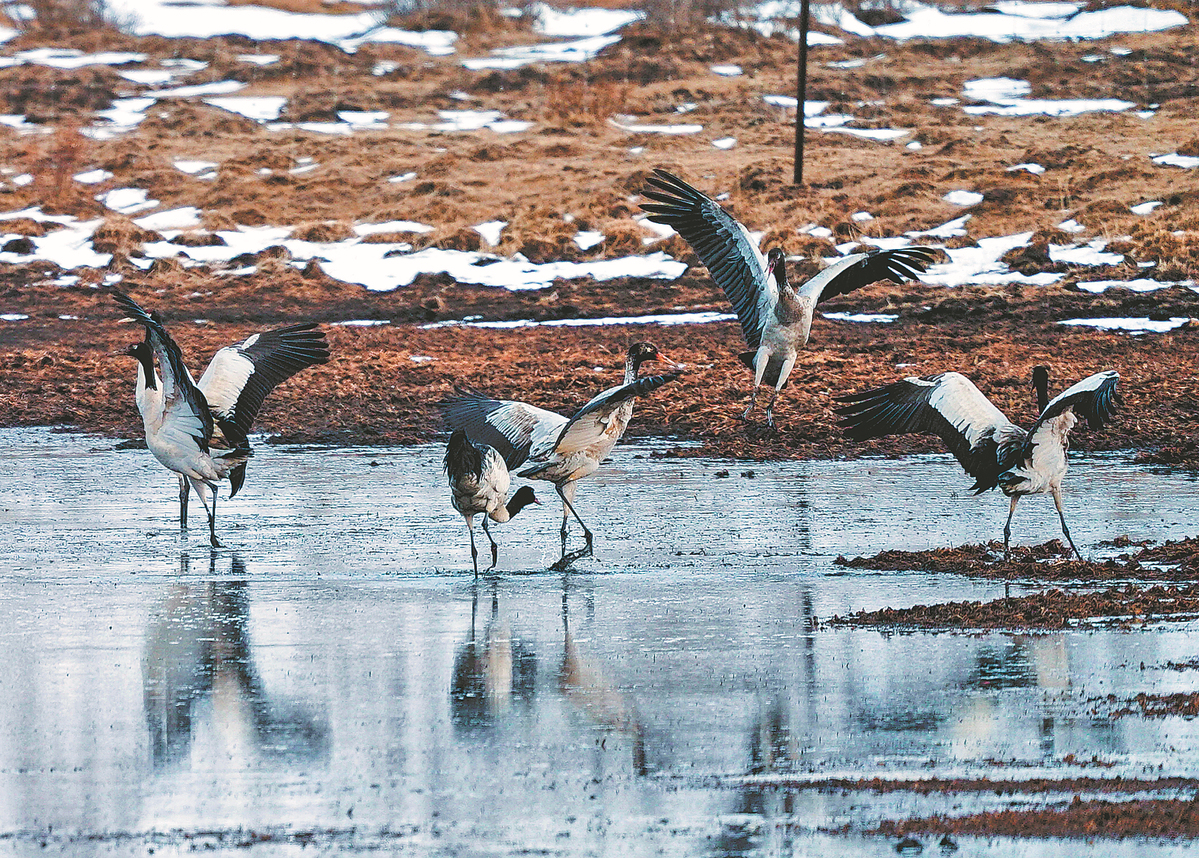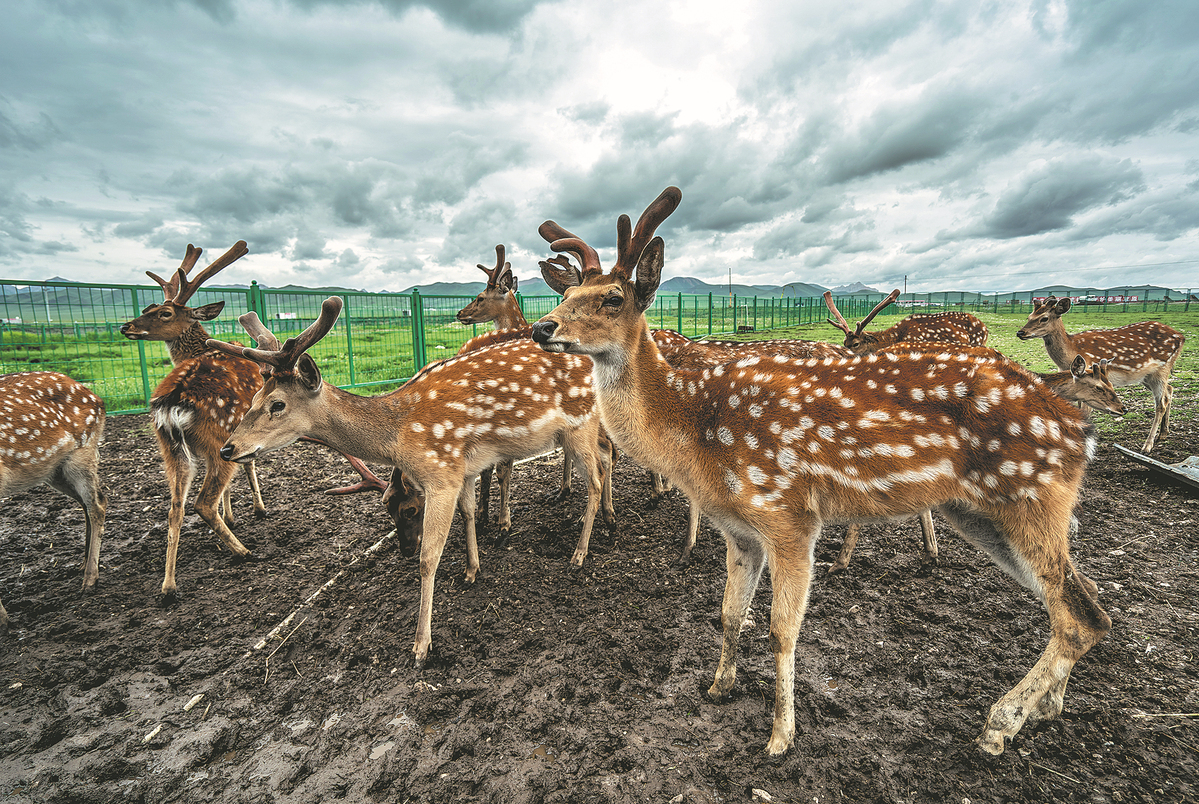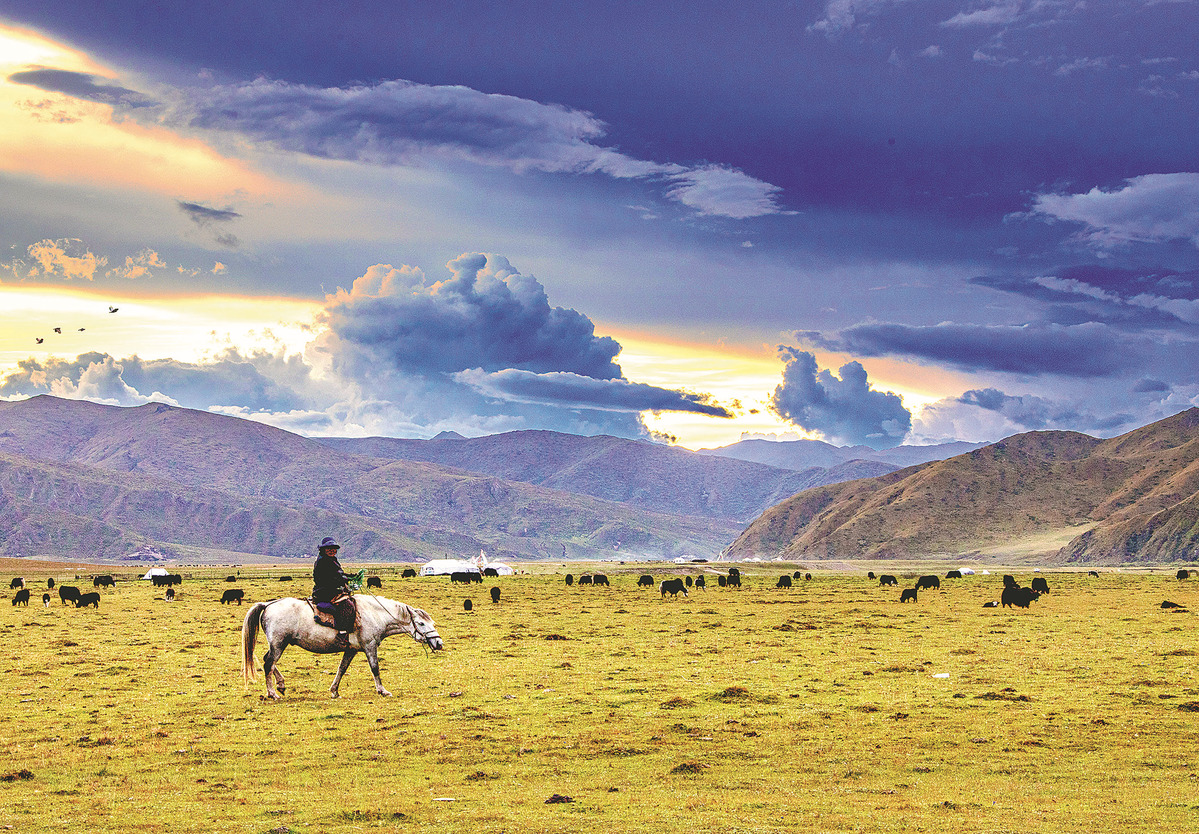Editor's note: As protection of the planet's flora, fauna and resources becomes increasingly important, China Daily is publishing a series of stories to illustrate the country's commitment to safeguarding the natural world.

Tourists take photos at the First Bend of the Yellow River scenic area in Zoige county, Sichuan province, in June. WANG XI/XINHUA
Living near the meandering watercourse of the Jiaqu, a tributary of the Yellow River, residents in Pema Lhade village in Aba county, Sichuan province, used to suffer a lot during the rainy season.
When the watercourse swelled with rainwater, floods would often erode its earthen banks, leading to substantial breaches. Consequently, the village area would swiftly become a vast expanse of water, hindering residents' ability to transport cattle or milk to the market, villager Tsetanpal said.
However, that scenario has become a thing of the past after a 5-kilometer embankment was built in 2010. What made the embankment special, however, was that it was built without the use of concrete.
Tsetanpal, 39, said he was relieved to finally be rid of the havoc caused by flooding.
As the country forges ahead with ecological protection and high-quality development in the Yellow River Basin, the "ecological embankment" built in Pema Lhade stands as an example of a series of environmentally friendly approaches governments have used to help conserve the mother river of the Chinese nation.
The country's central leadership has attached great importance to the conservation of the Yellow River.
President Xi Jinping has chaired three symposiums on the ecological protection and high-quality development of the Yellow River, with the first one taking place in Zhengzhou, capital of Henan province, on Sept 18, 2019. Wednesday marked its five-year anniversary.
"The protection of the Yellow River is critical to the great rejuvenation and sustainable development of the Chinese nation," Xi said, adding that it is a major national strategy.
In another symposium in Shandong provincial capital Jinan in 2021, Xi stressed that provincial-level regions along the Yellow River should stick to putting the environment first and being committed to green development.
In the third such meeting, which was held on Thursday in Gansu provincial capital Lanzhou, Xi called for implementing the strictest system for water resources protection and utilization.
It is important to promote a comprehensive green transformation of the development mode in the basin and to build a modern industrial system with distinctive advantages, the president said.

Tourists feed and take photos of birds at Flower Lake scenic area in Zoige in July last year. CHINA DAILY
Eco-friendly treatment
Standing on a bridge that crosses the grasslands of Pema Lhade village, visitors would find it hard to spot where the embankment is.
The environmentally friendly approach in building the embankment has made it difficult for people to detect traces of artificial construction, said Li Rui, deputy head of Aba's water service center.
Instead of cement, an "ecological bag" was used to build the embankment, which is filled with soil and grass seeds. "A concrete embankment will lead to a complete separation of the river and the wetland around it, cutting the exchange of water between them," he explained.
At a much lower cost, the ecological embankment has proved to work very well, he continued, eyeing the embankment now covered in lush grass, making the ecological bags underneath hardly visible from a distance.
Previously, substantial amounts of soil and sand were left on the riverbank after the floodwaters receded, leading to a continual rise in the riverbed, he explained. Furthermore, the floods eroded grasses along the shoreline, jeopardizing the grasslands that local residents rely on for their livelihoods.
As the most sediment-filled river on Earth, the Yellow River has seen its riverbed rise several meters above the surrounding ground in its lower reaches because of excessive sediment deposits. This makes soil erosion control an important aspect in the management of the Yellow River, though most of the sediment deposits in the 5,464-km waterway are mainly contributed by the Loess Plateau in its middle reaches.
The ecological embankments proved their effectiveness in addressing these challenges after undergoing successful testing over two rainy seasons, Li said, adding they may implement this approach in other areas in the near future.

Black-necked cranes forage for food at a wetland area in Hongyuan county, Sichuan, in April 2022. HE HAIYANG/FOR CHINA DAILY
Originating in Qinghai province, the Yellow River, often dubbed as the cradle of the Chinese civilization, runs through nine provinces and autonomous regions, including Sichuan and Henan, before emptying into the Bohai Sea in East China's Shandong province.
All sections of the Yellow River in Sichuan, which stretch for 174 km, are located in the Aba Tibetan and Qiang autonomous prefecture. In the prefecture, it passes through four counties — Aba, Songpan, Hongyuan and Zoige.
With its wetlands storing almost 10 billion cubic meters of water, the prefecture serves as a key supplier of water for the Yellow River in its upper reaches, contributing up to 40 percent of its water in low-flow periods and 26 percent during high-flow periods.
In Hongyuan, local authorities have been following a similar eco-friendly approach to treat the Nagpo Tsecbu River, another meandering watercourse.
When standing on a bridge in Anqu township in the county, visitors are immersed in a profound contrast between traditional embankment construction methods and the innovative eco-friendly approach.
One side of the river showcases a discordant blend of concrete-reinforced embankments, built years ago to address flood risks to a nearby community, against the natural backdrop, while the opposite bank unveils a distinctly contrasting scenery that is harmonious with its surrounding environment.
"It is built with wire mesh containers," said Jiang Jian, head of Hongyuan's bureau of ecology and environment. "These gabions combine flood protection necessities with a strong emphasis on ecological restoration, harmonizing effectively with the surrounding ecosystem."
The 9.6-km embankment was completed in October last year, and a series of other ecological remediation programs have also been rolled out along with it, including the restoration of more than 8 square km of grassland, according to Jiang.
Previously, the riverbank was often subjected to erosion, depleting the grasslands, he said. The embankments constructed with gabions, which have good water permeability, have not only addressed the problems but also prevented livestock waste from entering the river.
Sediment in the water can settle within the gaps of the filled stones, promoting the growth of natural vegetation and gradually restoring the original ecological environment, Jiang added.
"This area used to be a degraded grassland, severely affected by desertification, with vegetation coverage as low as 10 to 20 percent. After restoration, it now resembles the surrounding grasslands," he said.

Sika deer are raised on a patch of grassland in Zoige in July last year. The county has one of the largest wild groups of the animal. CHINA DAILY
Wetland remediation
Eco-friendly approaches have also been used in Aba prefecture to help restore wetlands, which have undergone substantial shrinkage due to the conversion of wetlands into grasslands by local herders.
In a pilot project to remediate Flower Lake, which annually replenishes about 4.4 billion cubic meters of water to the Yellow River, the Zoige National Nature Reserve Administration built a 1,740-meter dike using stone and soil in 2010 to help recover its water areas.
Over the past decade, the Flower Lake wetland has seen its water area expand from 215 to 650 hectares, with water levels rising by 52 centimeters. Additionally, a total of 892 hectares of marshlands were restored.
In Hongyuan, two small-scale gabion dikes and an additional 155 similar mini dikes of the same type have been constructed as part of an initiative for wetland restoration, launched in 2021.
At the Riganqiao Wetland, such dikes have also worked well in their remediation of damaged ecosystems.
Following the construction of a 1,760-meter gabion dike and another 100 mini dikes in 2022, 240 hectares of wetland have been remediated, with the water area in Riganqiao expanding by 200 hectares, said Yeyang Drolma, a wetland management official in Hongyuan.
Monitoring shows that the level of groundwater in the area covered by the project has risen by approximately 20 centimeters, she noted.
"The number of wild animal species monitored in the area has increased from 10 to 20. The black stork, a species very rare nationwide, has also been frequently spotted after the wetland restoration program," she said.
As a ranger who often patrols the area, Tsering Kyab is keenly aware of the significant changes that have occurred.
"When I was a child, there was so much water in the wetland that it was impassable for people and even for horses. Now, thanks to the project, the wetland of my childhood memory is coming back," he smiled.

A herder rides a horse on a grassland in Aba county, Sichuan, in September 2020. LIU GUOXING/FOR CHINA DAILY